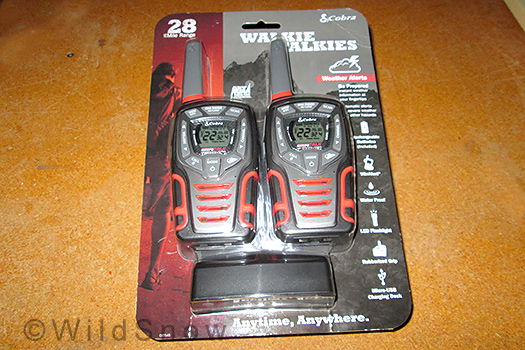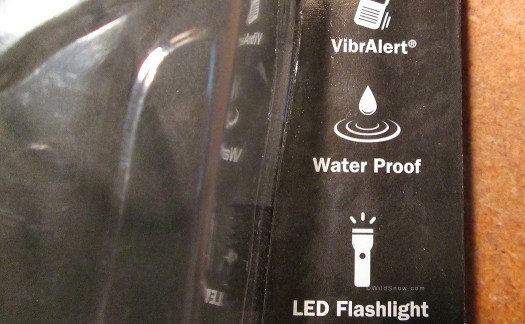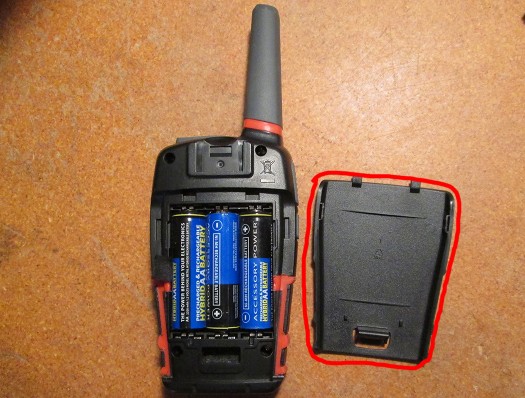
In the blister pack, Cobra CXT545 is a classy FRS/GMRS handheld.
Cobra CXT545 is an FRS/GMRS handheld 2-way radio that provides maximum legal (unlicensed) power and a modicum of rain and snow resistance. You can run them on any sort of AA battery (3 per radio), or install optional rechargeables that juice up when you connect to USB via direct cable or an included drop-in charger (which also works off USB). The radio will not function on USB power alone, though you can set up as a permanent station by installing rechargeables and leaving the USB hooked up.

Cobra CXT545 is compact. Protruding buttons are easily triggered by accident, lock mode turns most off but leaves the Call and Range (power) buttons sadly functioning. Weather mode is intuitive, easily grabbing local NOAA broadcasts if in range.
During testing we found the CXT545 to work reliably, though the stated “Waterproof” feature is actually only water resistance up to standard JIS4. Considering the battery case on the CXT545 is not gasketed let’s just say that in this iteration the radio is nicely splash proof, meaning it’ll work in the rain and snow so long as you store it correctly once you’re done (dry it, in other words, don’t put away wet.)
Controls are typical of most Cobra handhelds: A circle of rubber buttons around the LCD — easy to learn and use. Big one for us is the control lock function, invoked by holding the “Call” button down for about 5 seconds (same for unlocking). All good, except the lock function doesn’t disable the flashlight, which turns on and remains on when you click a button on the side of the unit — a recipe for draining the unit while in your backpack.
Ditto, while the unit is “Locked” the obnoxious “Call” button remains unlocked; all buttons are raised rather than protected by a bezel, so rest assured the “Call” button _will_ get pressed accidentally, thus prodding your partner with a blaring warble that she can’t turn OFF. As with other Cobra radios we’ve used, only solution for this is to razor blade the “Call” button down flush with the housing (memorize that it’s the Lock button if you do so!).
This is one of those times I wish I could grab a radio designer and playfully wring their neck. I mean, who thought up this “Call” button function? It is exactly the same thing as simply pressing the PTT (push to talk) and loudly saying something like “Hey, you there?” Or for that matter, just pressing PTT and slapping the radio against your leg, if you’d rather have non-verbal communication. Sheeeze, at the least, let the lock function lock out the “Call” button! Or hey, when in the setup and scrolling through the amazing 10! options for call button cacophony, how about one that’s a big fat 0? Rant over.
CXT545 has a high/low power option, in this case accessed with an obvious button on top of the screen. Fairly user friendly, only remember that due to FCC regulations the high power option is only available for channels 1 through 7 and 15 through 22. As with all blister pack radios, for backcountry use we recommend running at high power and simply keeping your transmissions short to preserve battery life. Switch to low power if you want to yammer and chatter (which sucks up battery on the talking side, not the receiving side).
Incidentally, if you’re new to FRS/GMRS radios remember that the lower channel numbers get more use due to them being quicker to scroll/access. If you’re in a high use area, say near a ski resort, switch to a number from 15 to 22, and use a quiet code. In super high use areas, scan for a while (CXT545 has a scan option) and pick a lesser used channel.

These are fairly good radios, just remember that they're not 'waterproof' but instead are splash resistant. In my experience, that means you can use them in light rain or snow, just remember not to store an an airtight humid condition once you're home. A bit more waterproofing would be good.

Battery case open (with our own hybrid AAs), no gasket but easy to access for swaps. Red circle indicates the battery cover where we wish we'd seen some rubber sealing things.
Other details: The rubberized side moldings (pinkish in photos) look gaudy but they’re practical, yielding a solid feel in the gloved hand and making the unit easy to spot if lost in the brush or buried in your cavernous backpack. PTT button is flat, hard to find with gloves but also resistant to accidental triggering. Antenna is solid, no risk of damage in normal use. Weather channels are appreciated and easy to select (just press the weather button then up-down channel till you find your local NOAA freq. LCD could be larger, with larger text for the small-print.
Weight 7.4 oz, 208 grams (with my Nmh batteries, lighter with lithiums.) See our two-way radio introduction article.
I’m seeing the CXT545 on Amazon for around $50.00 ($25.00 each), which is about right for this rig. MSRP of $89.95 is too high. They’re compact, powerful, and water resistant. On top of that, they’ll run just about any AA battery instead of using a dedicated rechargeable that’ll of course be empty when you need it (though a power saving system does help). If you’re comfortable with working the controls on Cobra FRS/GMRS radios and can live with the screaming “Call” button, these little bundles of joy will do what you need for a safe day in the backcountry.
WildSnow.com publisher emeritus and founder Lou (Louis Dawson) has a 50+ years career in climbing, backcountry skiing and ski mountaineering. He was the first person in history to ski down all 54 Colorado 14,000-foot peaks, has authored numerous books about about backcountry skiing, and has skied from the summit of Denali in Alaska, North America’s highest mountain.
